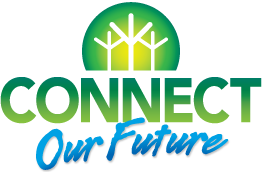A program aimed to permanently preserve farmland for the production of agricultural products. Conservation easements allow farmers to voluntarily conserve the farms they own into the future, by donating or selling easement rights, while at the same time being able to continue to farm and retain ownership. In exchange, the farmer may receive tax benefits or compensation.
Why is this important to your community?
The region lost over 350 farms between 2007 and 2012. While this loss of farms is reflective of national trends, there are tools available to communities interested in conserving their agricultural heritage. In addition, there is a growing demand in the region for local food products and the potential to grow the regional agricultural economy to meet this demand. Support for local farms is a priority of the CONNECT region, and agriculture is an essential part of the economy contributing to the local food system and local jobs related to packaging, distribution, and sales of food products and related equipment. Agriculture also feeds heritage tourism, including farm tours, which is on the rise in the CONNECT region.
Skip directly to
How Does It Work?
Resources
Using the Tool
Partners
Where Has It Worked?
Where is it appropriate to use?
What priorities does it address?
What other tools are related?
How does it work?
Agricultural Conservation Easements ensure that farmland is permanently preserved for the production of agricultural products. The easements allow farmers the ability to voluntarily conserve their land by donating or selling easement rights, while continuing to farm and retain ownership. The easement can be tailored to meet the farmer’s needs, and in exchange for agreeing to conservation easement terms, farmers may receive federal or state tax benefits as compensation. Owners of land not currently being farmed, but suitable for agriculture, may also donate or sell agricultural conservation easements. Land trusts are typically the holder of conservation easements; a program may also be designed for a county or municipality to administer the easements.
Resources
- CONNECT Our Future Food System Framework
- Appalachian Sustainable Agriculture Project
- Center for Environmental Farming Systems - A Community and Local Government Guide to Developing Local Food Systems
- NC Agricultural Development & Farmland Preservation Trust Fund Grants
- Carolina Farm Stewardship Association
- North Carolina’s Land Trusts
- Conservation Trust for North Carolina
- North Carolina Farmland Preservation Grants
- Catawba Farm and Food Coalition
- Pee Dee Land Trust, SC
- USDA Agricultural Conservation Easement Program
- American Farmland Trust
Ready to get started?
Using the Tool
- Research existing conservation easement programs in your county and state (see Resources section) and identify key farmers and major land owners, farmland advocates, and partner organizations / land trusts to assist in crafting a local conservation easement program.
- Determine the need for a natural environment inventory or agricultural conservation plan.
- If preparing an agricultural conservation plan, assign a point person to develop a working group of local landowners, farmers, agricultural support organizations, and residents to help advise in the preparation of the plan.
- If preparing a natural environment inventory, identify a county or municipal department to lead the inventory with assistance from state natural resources and COG planning .
- Coordinate with your local partners to develop the conservation easement program and determine how the program will be funded and administered (e.g., grants, dedicated local government funds, other). Involve local land trusts/conservancies, county and municipal officials, local legislators, farmers, tourism and/or economic development boards, Cooperative Extension representatives, and individual land owners in the drafting of the program.
- Consider advocating at the local, state, and federal level for additional funding for programs (tax credits and other compensation).
- Educate local residents and farmers about organizations engaged in conservation easement programs through educational materials, workshops and online resources.
Partners
Where has it worked?
Catawba Lands Conservancy - Catawba, Gaston, Iredell, Lincoln, Mecklenburg, and Union Counties, NC
About the Program
The Catawba Lands Conservancy (CLC), one of 24 non-profit land trusts in North Carolina, protects 176 properties covering 14,783 acres of vital land from development. The conservation lands include farmland, open spaces, wildlife habitats, and land near key water sources. As a community-based organization, CLC works with land owners, volunteers, local governments and land conservation advocates to identify and pursue protection and secure financing for conservation of land vital to the natural environment.
Why it works
CLC set a record for land protected in 2013 by securing the permanent conservation of 1,972 acres of land in the greater Charlotte region. The properties preserved by the CLC in 2013 include areas that protect biodiversity, restore riparian buffers within key watersheds, and provide land for future trails within the Carolina Thread Trail system. CLC finances conservation through local, state, and federal funding sources as well as private donations from individuals and corporations. Additional grants from the Conservation Trust of North Carolina’s Farmland Forever Fund (FFF) pay for miscellaneous costs associated with conservation including legal and acquisition fees. The Fork Farm and Stables (the Fork) in Norwood, North Carolina was one of the largest areas conserved by CLC in 2013 at 1,353 acres. The Fork includes land devoted to wildlife and productive farming practices where farmers grow hay, alfalfa, orchard grass, corn, sunflowers, and much more on 100 acres of agriculture plots outside of the horse stables and lodging areas. CLC was also able to secure Clean Water Management Trust Fund grants by working with the Centralina Council of Governments and three counties to purchase major portions of the land adjacent to Mountain Island Lake, Mecklenburg County’s major drinking water source.



